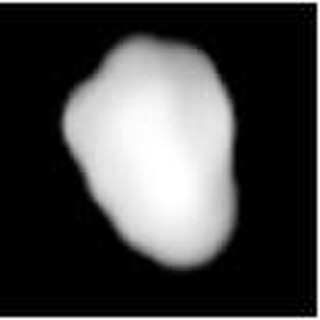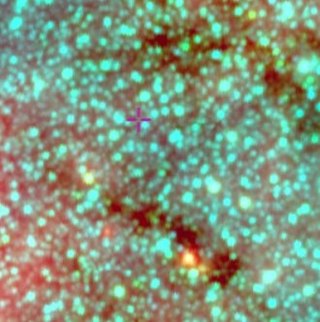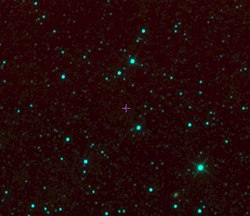
In astronomy, a light curve is a graph of the light intensity of a celestial object or region as a function of time, typically with the magnitude of light received on the y-axis and with time on the x-axis. The light is usually in a particular frequency interval or band.

Metis is one of the larger main-belt asteroids. It is composed of silicates and metallic nickel-iron, and may be the core remnant of a large asteroid that was destroyed by an ancient collision. Metis is estimated to contain just under half a percent of the total mass of the asteroid belt.

Arethusa is a large main-belt asteroid. It was discovered by German astronomer Robert Luther on 23 November 1867, and named after one of the various Arethusas in Greek mythology. Arethusa has been observed occulting a star three times: first on 2 February 1998, and twice in January 2003.

Lydia is a large belt asteroid with an M-type spectrum, and thus may be metallic in composition, consisting primarily of nickel-iron. It was discovered by French astronomer Alphonse Borrelly on 19 April 1870 and was named for Lydia, the Asia Minor country populated by Phrygians. The Lydia family of asteroids is named after it.

54 Piscium is an orange dwarf star approximately 36 light-years away in the constellation of Pisces. In 2003, an extrasolar planet was confirmed to be orbiting the star, and in 2006, a brown dwarf was also discovered orbiting it.
659 Nestor is a dark Jupiter trojan from the Greek camp, approximately 110 kilometers in diameter. It was discovered on 23 March 1908, by German astronomer Max Wolf at Heidelberg Observatory in southern Germany, and named after King Nestor from Greek mythology. The carbonaceous Jovian asteroid belongs to the 20 largest Jupiter trojans and has a rotation period of 15.98 hours.
HD 156846 is a binary star system in the equatorial constellation of Ophiuchus, positioned a degree SSE of Messier 9. It has a yellow hue and is just barely bright enough to be visible to the naked eye with an apparent visual magnitude of 6.5. The system is located at a distance of 156 light years from the Sun based on parallax. It is drifting closer with a radial velocity of −68.5 km/s, and is predicted to come to within 85.0 light-years in about 476,000 years.
24 Sextantis, often abbreviated as 24 Sex, is the Flamsteed designation of a 7th-magnitude star located approximately 236 light years away in the constellation of Sextans. At an apparent visual magnitude of 6.61, this star can only be viewed from rural skies under good seeing conditions.

1SWASP J140747.93−394542.6 is a star in the constellation Centaurus at a distance of about 434 light-years from Earth. A relatively young star, its age is estimated to be 16 million years, and its mass is about 90% that of the Sun. The star has an apparent magnitude of 12.3 and requires a telescope to be seen. The star's name comes from the SuperWASP program and the star's coordinates. The star is variable due to the planet orbiting around it and has been given the variable star designation V1400 Centauri.

The Next-Generation Transit Survey (NGTS) is a ground-based robotic search for exoplanets. The facility is located at Paranal Observatory in the Atacama desert in northern Chile, about 2 km from ESO's Very Large Telescope and 0.5 km from the VISTA Survey Telescope. Science operations began in early 2015. The astronomical survey is managed by a consortium of seven European universities and other academic institutions from Chile, Germany, Switzerland, and the United Kingdom. Prototypes of the array were tested in 2009 and 2010 on La Palma, and from 2012 to 2014 at Geneva Observatory.

Tabby's Star is an F-type main-sequence star in the constellation Cygnus approximately 1,470 light-years from Earth. Unusual light fluctuations of the star, including up to a 22% dimming in brightness, were discovered by citizen scientists as part of the Planet Hunters project. In September 2015, astronomers and citizen scientists associated with the project posted a preprint of an article describing the data and possible interpretations. The discovery was made from data collected by the Kepler space telescope, which observed changes in the brightness of distant stars to detect exoplanets.

Tabetha "Tabby" Suzanne Boyajian is an American astronomer of Armenian descent and astrophysicist on faculty at Louisiana State University. She was a post-doctoral fellow 2012–16 at Yale University, working with Debra Fischer. Boyajian is active in the astronomical fields of stellar interferometry, stellar spectroscopy, exoplanet research, and high angular resolution astronomy, all particularly at optical and infrared wavelengths. She was the lead author of the September 2015 paper "Where's the Flux?", which investigated the highly unusual light curve of KIC 8462852; the star is colloquially known as Tabby's Star in her honor.
WD 1145+017 is a white dwarf approximately 570 light-years (170 pc) from Earth in the constellation of Virgo. It is the first white dwarf to be observed with a transiting planetary-mass object orbiting it.
2MASS J21265040−8140293, also known as 2MASS J2126−8140, is an exoplanet orbiting the red dwarf TYC 9486-927-1, 111.4±0.3 light-years away from Earth. Its estimated mass, age, spectral type (L3), and Teff are similar to the well-studied planet β Pictoris b. With an estimated distance of around 1 trillion kilometres from its host star, it is one of the largest solar systems ever found.

In astronomy, a disrupted planet is a planet or exoplanet or, perhaps on a somewhat smaller scale, a planetary-mass object, planetesimal, moon, exomoon or asteroid that has been disrupted or destroyed by a nearby or passing astronomical body or object such as a star. Necroplanetology is the related study of such a process. Nonetheless, the result of such a disruption may be the production of excessive amounts of related gas, dust and debris, which may eventually surround the parent star in the form of a circumstellar disk or debris disk. As a consequence, the orbiting debris field may be an "uneven ring of dust", causing erratic light fluctuations in the apparent luminosity of the parent star, as may have been responsible for the oddly flickering light curves associated with the starlight observed from certain variable stars, such as that from Tabby's Star, RZ Piscium and WD 1145+017. Excessive amounts of infrared radiation may be detected from such stars, suggestive evidence in itself that dust and debris may be orbiting the stars.

ASASSN-V J213939.3-702817.4 is a star, previously non-variable, found to be associated with an unusual, deep dimming event that was uncovered by the All Sky Automated Survey for SuperNovae (ASAS-SN) project, and first reported on 4 June 2019 in The Astronomer's Telegram.

VVV-WIT-07 is a unique variable star which presents a sequence of recurrent dimmings with a possible deep eclipse in July 2012. The star, located in the Scorpius constellation about 23,000 ly (7,100 pc) away, is not a binary star, which would eliminate such a system from explaining the various observed dimmings.

HD 139139 is likely part of a bound pair system of main sequence stars about 350 light-years away from Earth in the constellation Libra. HD 139139 is a G-type main-sequence star, a little larger and more luminous than the Sun, and at an almost identical temperature. It has an apparent magnitude of 9.8. The companion star is thought to be a K5-7 red dwarf 3.3″ away from HD 139139. It is about three magnitudes fainter and has a temperature of between 4,100 and 4,300 K. Both stars have a similar proper motion, meaning they may form a gravitationally-bound binary pair.
Tidally detached exomoons, also known as orphaned exomoons or ploonets, are hypothetical exoplanets that were formerly exomoons of another planet, before being ejected from their orbits around their parent planets by tidal forces during planetary migration, and becoming planets in their own right. As of 2023, no tidally detached moons have yet been definitively detected, but they are believed to be likely to exist around other stars, and potentially detectable by photometric methods. Researchers at Columbia University have suggested that a disrupting detached exomoon may be causing the unusual fluctuations in brightness exhibited by Tabby's Star.

















